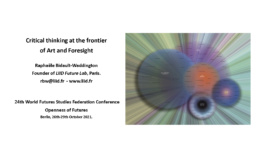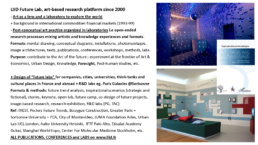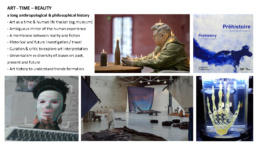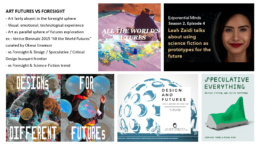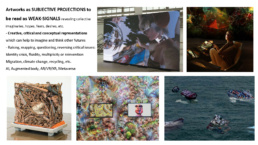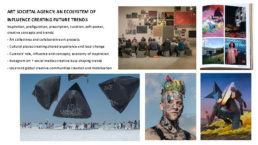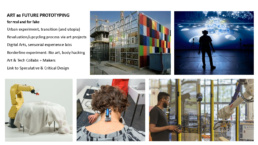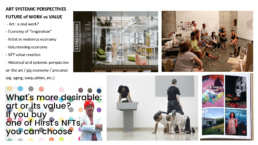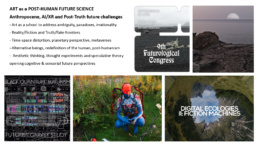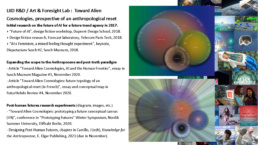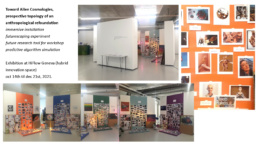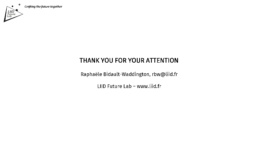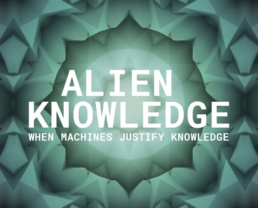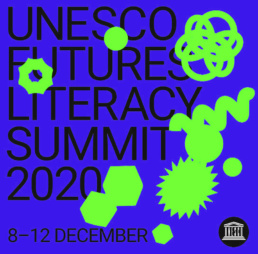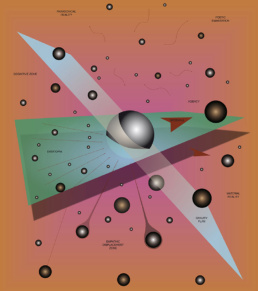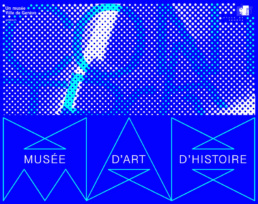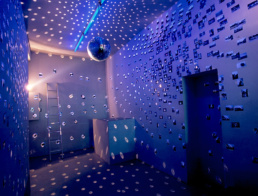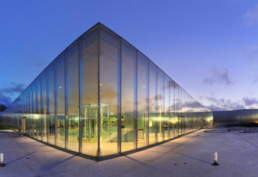Critical Thinking at the Frontier
of Art and Foresight
The Openness of Futures, 24th World Future Studies Federation (WFSF) World Conference (online program), Berlin, 2021.
Approfondissant l’intervention faite en 2020 à l’UNESCO, cette conférence revient d’abord sur la question du Temps qui est au cœur de l’art, celui-ci étant non seulement un marqueur, mais aussi à nombreux égard un véhicule d’exploration et de voyage temporel, que ce soit vers le passé, le présent ou le futur, dans toute leur multiplicité.-Du côté de l’avenir, les écosystèmes artistiques produisent un foisonnement de signe du changement qu’il reste à décrypter. Ils font aussi émerger des tendances et des prototypes contribuant à la fabrique du futur dans de très nombreux domaines (technologies, éducation, bien-être, vie citoyenne, etc.). Ils constituent en réalité un véritable de laboratoire de recherche spéculative, par exemple sur la question du futur du travail ici mise en lumière.
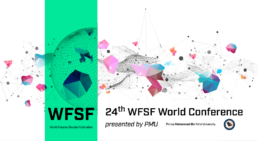
Abstract
If Art has always been a source of inspiration to Foresight, its critical frontier and contribution to Future research is still under-discussed – as opposed to Design (Candy) or Science-Fiction (Zaidi). In this communication, we will show via a rich selection of references, how contemporary art practices and critical thinking can open futures. If futurism is the explicit intention of few artistic movements in the 20th and 21st century, Art is not dedicated to the future per se.
Art operates as a non-conventional anthropological time tracker and time traveler, alongside mankind’s past, present and future. Its multicultural and non-instrumental character creates space to re-define and decolonize visions of the past, historical “truths” or past futures, provides a multi-perspective lens on the present, and lays the ground for alternative insights on the future.
Beyond their visual or affective dimensions (generally considered in foresight), Art productions can be read as weak-signals revealing societal transformations, imaginaries and trends in all domains. Since the 90’s, certain artists, curators and critics have seen Art as a critical laboratory, questioning related value-systems and philosophical frames, the very principle of interpretation and speculation, and the porous border between reality and fiction.
Exploring the depth of the aesthetic experience via Art supports the investigation of the many facets of the future, that other ambiguous fiction. Art thus complements the more performative and use-centric prism of Design on the future.
Then Art experimentation and communities can also prototype futures, incubate societal, technological or urban transformations, and shape cultural trends via their live and virtual ecosystems of influence.
Finally, more recent artistic research projects create innovative methods and trans-disciplinary and speculative rationales, which open new entries and contributions to Futures Literacy and Foresight knowledge at large. TAC Future Lab is positioned on this specific zone of artistic and foresight innovation.
RBW
Slides de l'intervention
A propos de The Openness of Futures, 24th WFSF Global Conference
The conference theme reflects the broad dimensions and dynamics of futures studies and describes an arena in which we explore the expansiveness of our imagination – an open universe prepared to deal with the grand challenges of our time, beautifully articulated as desirable visions of sustainable progress and hope.
The Openness of Futures is an invitation to travel into a new era for futures.
In these futures you will be able to experiment with technology enhanced methods and teaching, transdisciplinary approaches to opportunity-based problem solving and new paradigms and concepts for global collaboration and societal development.
Site et programme de la conférence : wfsfconferenceberlin2021.org
Rappel des axes de recherche du lab
Axe 1 : Transitions et Mondes Futurs
Axe 2 : Innovation Méthodologie Prospective
Axe 3 : Art et Recherche Prospective
Articles associés à celui-ci
Do They Dream of Electric Sheep?, Muzeum Susch, Suisse, 2018
Dans cette keynote, RBW vient partager ses réflexions artistiques et prospectives sur les enjeux de l’IA et la…
Art x Futures, ‘Blended Futures’ Foresight Journal panel, UNESCO FL Summit, 2020
En s’appuyant sur de nombreux exemples internationaux, la présentation repart du fait que les productions artistiques…
Art & Future Research, Alliance for Artistic Research in Universities, USA, 2022
RBW reparcourt le développement de ses laboratoires depuis leur ancrage dans l’héritage de l’art conceptuel et…
Futur des Musées, Musée d’Art et d’Histoire, Genève, 2022-23
Ce vaste programme d'exploration sur le futur des musées étalé sur une dizaine de mois, a permis d’inséminer de manière…
Researching the Future through Art, IFTF Foresight Talks, 2023
Le prestigieux Institute For The Future de Palo Alto invite dans ce webinar RBW à présenter son écosystème de recherche…
Journée Art, Innovation et Prospective, Louvre Lens Valley, 2024
Destinée à l’écosystème d’innovation du musée du Louvre Lens, cette journée ‘futur lab’ comprenait trois masterclass…
